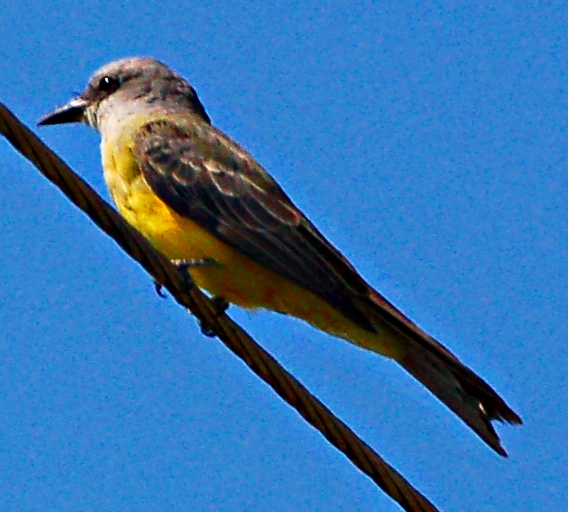- Tropical Kingbird
Taxobox
name = Tropical Kingbird

image_width = 240px
image_caption =
status = LC
status_system = iucn3.1
regnum =Animalia
phylum =Chordata
classis =Aves
subclassis =Neornithes
infraclassis =Neognathae
superordo =Neoaves
ordo =Passeriformes
subordo =Tyranni
infraordo =Tyrannides
familia =Tyrannidae
genus = "Tyrannus "
species = "T. melancholicus"
binomial = "Tyrannus melancholicus"
binomial_authority = (Vieillot,1819 )The Tropical Kingbird ("Tyrannus melancholicus") is a large
tyrant flycatcher . Thisbird breeds from southernArizona and the lowerRio Grande Valley ofTexas in theUSA throughCentral America ,South America as far as south as centralArgentina and westernPeru , and onTrinidad and Tobago . Birds from the northernmost and southern breeding areas migrate to warmer parts of the range after breeding.An adult Tropical Kingbird is 22cm long and weighs 39g. The head is pale grey, with a darker eye mask, an orange crown stripe, and a heavy grey bill. The back is greyish-green, and the wing and forked tail are brown. The throat is pale grey, becoming olive on the breast, with the rest of the underparts being yellow. The sexes are similar, but young birds have pale buff edges on the wing coverts.
The call is a high-pitched twittering trill, "tree-e-e-e-e-e-e", with a more complex version sung by the male at dawn.
Their breeding habitat is semi-open areas with trees and shrubs, including gardens and roadsides. Tropical Kingbirds like to observe their surroundings from a prominent open perch, usually high in a tree, undertaking long sally flights to acrobatically catch
insect s in mid-air, sometimes hovering to pick food off vegetation [de A. Gabriel & Pizo (2005), Pascotto (2006)] . They also eat somefruit [E.g. from "Alchornea glandulosa ", "Cymbopetalum mayanum " (Annonaceae ) andGumbo-limbo ("Bursera simaruba"): Pascotto (2006), Foster (2007).] , foraging for these even in disturbed habitat. These birds aggressively defend their territory against intruders, even much larger birds such asMagnificent Frigatebird s,toucan s,caracara s orhawk s.They make a flimsy cup nest in a tree. The female incubates the typical clutch of two or three cream eggs, which are marked with reddish-brown, for 16 days, with about 18-19 further days to fledging.
Footnotes
References
*|year=2004|id=50061|title=Tyrannus melancholicus|downloaded=12 May 2006 Database entry includes justification for why this species is of least concern
* (2005): Foraging behavior of tyrant flycatchers (Aves, Tyrannidae) in Brazil. "Revista Brasileira de Zoologia" 22(4): 1072–1077 [English with Portuguese abstract] . doi|10.1590/S0101-81752005000400036 [http://www.scielo.br/pdf/rbzool/v22n4/a36v22n4.pdf PDF fulltext]
* (1991): "A guide to the birds of Trinidad and Tobago" (2nd edition). Comstock Publishing, Ithaca, N.Y.. ISBN 0-8014-9792-2
* (2007): The potential of fruiting trees to enhance converted habitats for migrating birds in southern Mexico. "Bird Conservation International" 17(1): 45-61. doi|10.1017/S0959270906000554 [http://journals.cambridge.org/production/action/cjoGetFulltext?fulltextid=936412 PDF fulltext]
* (2003): "Birds of Venezuela". Christopher Helm, London. ISBN 0-7136-6418-5
* (2006): Avifauna dispersora de sementes de "Alchornea glandulosa" (Euphorbiaceae) em uma área de mata ciliar no estado de São Paulo [Seed dispersal of "Alchornea glandulosa" (Euphorbiaceae) by birds in a gallery forest in São Paulo, southeastern Brazil.] . "Revista Brasileira de Ornitologia" 14(3): 291-296 [Portuguese with English abstract] . [http://www.ararajuba.org.br/sbo/ararajuba/artigos/Volume143/ara143not5.pdf PDF fulltext]
Wikimedia Foundation. 2010.
